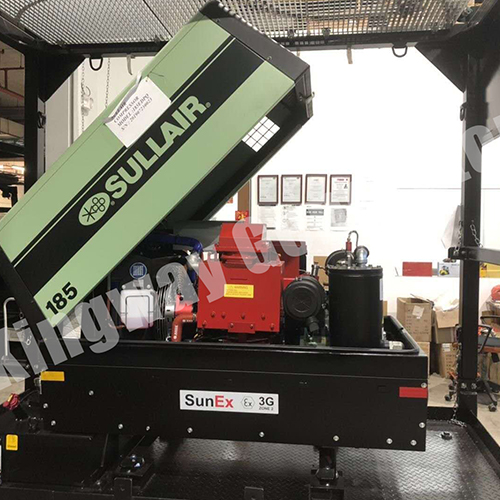-
 English
English
- [email protected]
- +86-532-55718566
Four Sets ATEX certified Explosion proof 185CFM Sullair Diesel driven zone 2 air compressors for applications in Hazardous Area ( Zone 2 ) mounted in the DNV certified 2.7-1 Skid have been successfully pass through ATEX and DNV certificate ready to send to client.

Kingway hazardous area equipment department always commit to the safe, reliable and enhanced performance Zone 2 equipment in projects in oil & gas field or industry, offshore & onshore service. As one of the top brand of hazardous area explosion proof solution, is your reliable and trusted partner in explosion proof industry.
Before, seeing the expression "Hazardous Location" ordinarily implied that the hardware being mentioned was bound for a compound plant, treatment facility, or penetrating stage. Today, we are seeing hazardous areas in sugar factories, grain storerooms, and anyplace there might be combustible fluids, gasses, or dust present. Hazardous regions are characterized as territories where the presence of combustible gases or fluids, flammable tidies, or effectively touched off strands exist in adequate fixations to cause a fire or blast, given a wellspring of start. These regions run from segments of a space to entire plant locales.
Mostly because of this extended utilization of the order framework, specifiers are progressively referring to prerequisites for gear appropriate for use in characterized regions. When appropriately utilized, the hazardous region order framework makes for a more secure workplace. Time and again, notwithstanding, risk classes are determined without worry for the essentially higher plan and acquirement costs they bring. Much of the time, a receptive outlook and a little resourcefulness can evade extreme expenses for blowers and other gear, without bargaining security.
There are a few contrasts between the order framework in North America and the framework utilized in different pieces of the world. In North America, the most well-known technique for characterizing hazardous territories is by Class, Division, and Group. Classes are utilized to recognize the sort of material that might be found in the environment:
Divisions are utilized to recognize the likelihood that an ignitable substance will be in the climate in fixations that would uphold start:
Gatherings are recorded as A through G. Gatherings A through D distinguish gases and fumes and apply to Class I areas. Gatherings E through G recognize ignitable cleans and apply to Class 11 areas. The level of combustibility is in sequential order, with A being the most combustible and D being the least combustible gases and fumes, and E being the most combustible and G being the least combustible tidies.
These orders can be found in National Fire Protection Association (NFPA) Section 500 and 505. Area 505 is a more up to date segment that is organized to orchestrate the NFPA codes with the Zone evaluations utilized outside of North America.
In Europe and different pieces of the world, a Zone rating is utilized. This is like the North American framework with some slight contrasts.